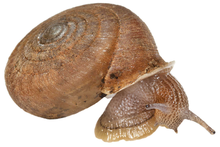|
Gudeodiscus giardi
Gudeodiscus giardi is a species of air-breathing land snail, a terrestrial pulmonate gastropod mollusk in the family Plectopylidae. This species was described by French zoologist Pierre Marie Henri Fischer (1865-1916) (son of Paul-Henri Fischer) in 1898. Subspecies
The specific name giardi is in honor of French zoologist Alfred Mathieu Giard.[1] The subspecific name oharai is in honor of the collector Kenji Ohara.[3] The subspecific name szekeresi is in honor of the malacologist Miklós Szekeres.[3] DistributionThe distribution of Gudeodiscus giardi includes Cao Bằng Province and the northern part of Lạng Sơn Province in Vietnam[2] and western Guangxi in China.[3] The type locality of Gudeodiscus giardi giardi is "Cao-Bang".[1][2] Gudeodiscus giardi giardi lives in Vietnam and China.[3] Gudeodiscus giardi oharai lives in are north of Nanning in Western Guangxi, China.[3] Gudeodiscus giardi szekeresi live in the type locality only: Langur Reserve, 25 km southeast of Chongzuo, China.[3] DescriptionThe most important shell characters for identification of Gudeodiscus giardi include: high and rather sharply defined shell shape, narrow umbilicus (for the genus Gudeodiscus) and thick peristome.[2] The size of the shell is small to large.[2] The shape of the shell is high and rather sharply defined.[2] The color of the shell is brownish, but some Chinese populations are small and yellow and translucent.[2] The sculpture is usually finely reticulated, that is resulting in a matt surface.[2] The umbilicus is deep.[2] Apertural lip, callus and apertural fold are very well-developed (callus is very much elevated).[2] Parietal wall has two lamellae.[2] The anterior lamella is usually connected to the lower plica.[2] Middle palatal plicae are short, depressed Z-shaped, or almost vertical, sometimes connected to each other.[2] The width of the shell 13.5–21.3 mm.[2] The height of the shell is 7.0–12.1 mm.[2] The radula of Gudeodiscus giardi has 12 lateral teeth and 15 marginal teeth.[2] The size of the central tooth is as large as the ectocone of the first lateral.[2] The shape of the first lateral is rhomboid and pointed.[2] Marginal teeth are bicuspid or tricuspid with blunt inner cusp and shallow incision between the inner two cusps.[2] The reproductive system of specimen from China was described by Páll-Gergely & Asami in 2014[4] and from Vietnam by Páll-Gergely et al. in 2015.[2] Embryos were not recorded in the uterus.[2] There were recorded hook-like or flat and oval calcareous granules on the internal surface of penis.[2] EcologyIt is a ground-dwelling species as all other plectopylid snails in Vietnam.[2] It co-occur with other plectopylids in Vietnam: with Gudeodiscus anceyi, Gudeodiscus francoisi, Sicradiscus mansuyi and with Gudeodiscus suprafilaris.[2] Gudeodiscus phlyarius live at geographically close sites to Gudeodiscus giardi.[2] ReferencesThis article incorporates Creative Commons (CC-BY-4.0) text from the reference[2]
|
||||||||||||||||||||||||||||||||
Portal di Ensiklopedia Dunia
